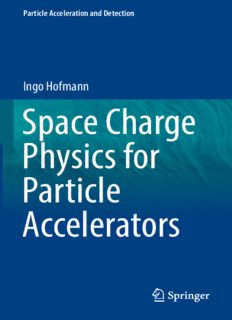
Space charge physics for particle accelerators PDF
Preview Space charge physics for particle accelerators
Particle Acceleration and Detection Ingo Hofmann Space Charge Physics for Particle Accelerators Particle Acceleration and Detection SeriesEditors AlexanderChao SLAC MenloPark,CA USA FrankZimmermann CERN SL-Division APGroup Genève Switzerland KatsunobuOide KEK HighEnergyAcceleratorResearchOrg. Berlin Germany WernerRiegler CERN Genève Switzerland VladimirShiltsev FermiNationalAcceleratorLab AcceleratorPhysicsCenter Batavia,IL USA The series Particle Acceleration and Detection is devoted to monograph texts dealingwithallaspectsofparticleaccelerationanddetectionresearchandadvanced teaching.Thescopealsoincludestopicssuchasbeamphysicsandinstrumentation as well as applications. Presentations should strongly emphasise the underlying physicalandengineeringsciences.Ofparticularinterestare (cid:129) contributions which relate fundamental research to new applications beyond theimmeadiaterealmoftheoriginalfieldofresearch (cid:129) contributions which connect fundamental research in the aforementionned fieldstofundamentalresearchinrelatedphysicalorengineeringsciences (cid:129) conciseaccountsofnewlyemergingimportanttopicsthatareembeddedina broaderframeworkinordertoprovidequickbutreadableaccessofverynew materialtoalargeraudience. Thebooksformingthiscollectionwillbeofimportanceforgraduatestudentsand activeresearchersalike. Moreinformationaboutthisseriesathttp://www.springer.com/series/5267 Ingo Hofmann Space Charge Physics for Particle Accelerators 123 IngoHofmann GSI/TechnicalUniversity Darmstadt,Germany Goethe-University Frankfurt ISSN1611-1052 ISSN2365-0877 (electronic) ParticleAccelerationandDetection ISBN978-3-319-62156-2 ISBN978-3-319-62157-9 (eBook) DOI10.1007/978-3-319-62157-9 LibraryofCongressControlNumber:2017951135 ©TheAuthor(s)2017 Thisworkissubjecttocopyright.AllrightsarereservedbythePublisher,whetherthewholeorpartof thematerialisconcerned,specificallytherightsoftranslation,reprinting,reuseofillustrations,recitation, broadcasting,reproductiononmicrofilmsorinanyotherphysicalway,andtransmissionorinformation storageandretrieval,electronicadaptation,computersoftware,orbysimilarordissimilarmethodology nowknownorhereafterdeveloped. Theuseofgeneraldescriptivenames,registerednames,trademarks,servicemarks,etc.inthispublication doesnotimply,evenintheabsenceofaspecificstatement,thatsuchnamesareexemptfromtherelevant protectivelawsandregulationsandthereforefreeforgeneraluse. Thepublisher,theauthorsandtheeditorsaresafetoassumethattheadviceandinformationinthisbook arebelievedtobetrueandaccurateatthedateofpublication.Neitherthepublishernortheauthorsor theeditorsgiveawarranty,expressorimplied,withrespecttothematerialcontainedhereinorforany errorsoromissionsthatmayhavebeenmade.Thepublisherremainsneutralwithregardtojurisdictional claimsinpublishedmapsandinstitutionalaffiliations. Printedonacid-freepaper ThisSpringerimprintispublishedbySpringerNature TheregisteredcompanyisSpringerInternationalPublishingAG Theregisteredcompanyaddressis:Gewerbestrasse11,6330Cham,Switzerland Tomydearchildren Nadi,Nura,AnisaandAmin Preface The motivation for this book on space charge in particle accelerators has emerged from the continuing interest in the understanding and controlling of space charge effects in operating high-intensity particle accelerators and the numerous projects still under construction or in development, many of which are the world’s largest instrumentsatthefrontierofscientificandtechnicaldevelopment. Thisbookfocusestoalargeextentontheauthor’sangleontheoreticalconcepts ofresonancesandinstabilities,inparticulartheircoherentexpressions,andattempts to connect them with simulationresults and – ina limitednumber of cases –with experiments. Although these topics are well known in the accelerator community inthebroadcontextofimpedancesorwakefields,theirapplicationtodirectspace chargeisnotyetequallywellestablished.Utilizingtermslikecoherentspacecharge resonances or coherent parametric instabilities may be sometimes challenging; it is hoped that they will be useful to create a more systematic and differentiating picture of space charge effects, which is the primary scope of this book. It is thus complementarytoexistingtextbooksonacceleratorsandbeamdynamicswiththeir muchbroaderscope,whichareneededforunderstandingthemesthatcouldnotbe adequatelyaddressedintheformatofthisbook. Theapplicationofthematerialpresentedhereisseeninthefieldoflinearhadron accelerators at non-relativistic energies, but also in space charge issues in circular accelerators, like injector synchrotrons, all at basically non-relativistic energies, wheredirectspacechargeissuesareofconcern. A personal remark: In preparing this manuscript, I have found time and again how challenging it is to map theoretical concepts of space charge effects to the boundary conditions of real accelerators. This is particularly true for linear accelerators,whereahighlevelofspacechargeisembeddedinoftenquitecomplex andtransientaccelerationstructures. Nonethelessitishopedthatthematerialpresentedheremaybeusefultoallthose whofindthatrunningacomputersimulationcodeisnotenoughandwhobelievethat tryingtounderstandthegapbetweenanalyticalconcepts,multiparticlesimulations andexperimentsisthebestwaytoadvance. vii viii Preface IamgratefultomanycolleaguesatGSIDarmstadt,Goethe-UniversitätFrank- furtandTechnischeUniversitätDarmstadt,amongthemOliverBoine-Frankenheim, Giuliano Franchetti, Lars Groening, Vladimir Kornilov and Jürgen Struckmeier, for the many valuable discussions. Among my international colleagues, I am particularly indebted to the late Martin Reiser, who shared his insight into space charge over many years, which I cannot adequately value. I am also grateful to Bob Jameson, who stimulated the early work on beam anisotropy; to the late Bob Gluckstern and to Robert Ryne and Tom Wangler for many inspiring discussions; andtoDidierUriotforhissupport,inparticularbydevelopinghelpfuldiagnostic features (such as stability charts and tune footprints) in TRACEWIN. Last but not least, I am extremely grateful for having received highly constructive and appreciatedcommentsonthefullmanuscriptbyMortezaAslaninejad,BobJameson andUweNiedermayerandbyYongLiu,JiQiangandRobRyneonselectedtopics. ThanksgotoAlexChaoalsoforhisvaluableconceptualcomments. Darmstadt,Germany IngoHofmann June2017 Contents 1 Introduction................................................................. 1 2 PhaseSpaceDynamicsinTheoryandSimulation...................... 9 3 VlasovandEnvelopeAnalysis............................................. 21 4 MatchedBeams............................................................. 27 5 ModesofSpaceChargeInteraction...................................... 41 6 BeamMismatchandHalo................................................. 71 7 CoherentParametricInstabilities ........................................ 81 8 MagnetErrorDrivenResonances........................................ 115 9 EmittanceExchangeinAnisotropicBeams.............................. 131 10 DiscussionofSpaceChargeinAcceleratorDesign ..................... 145 Epilogue........................................................................... 151 Glossary........................................................................... 153 ix Chapter 1 Introduction Noonebelievesthesimulationresultsexcepttheonewho performedthecalculation,andeveryonebelievesthe experimentalresultsexcepttheonewhoperformedthe experiment. [Quotefrom:MartinGreenwald,MassachusettsInstituteof Technology,in[1]] Abstract A short historical account of the early development on space charge in acceleratorssincethe1960sisfollowedbyalistofbooksofreferenceonthewider fieldofacceleratorphysics.Aproperdistinctionofincoherent andcoherent inthe contextofresonanteffectsinspacechargedominatedbeamsiscrucial.Anequally importantdistinctionisthatbetweenexternallyexcitedresonances–forexampleby errorfields–andparametricallydrivenresonantinstabilities,furthermorebetween isotropicandanisotropicbeams.Aconceptualizationoftheseterms–bypresenting akindofguidelineforthefollowingchapters–ispresentedintheintroductionand intended as a hopefully useful framework for interpretation of theory, simulation andexperiments. Modern particle accelerators are not thinkable without the tremendous progress in computer simulation for beam dynamics since the 1970s. Narrowing the gap between simulation models and observation of beams in real accelerators has remained a challenging task. The above quote from the context of hydrodynamic and plasma simulations, which have also prepared the ground for a great deal of acceleratorbeamdynamicssimulation,hasremainedvaliduntiltoday. Thisisparticularlytrueforthelarge-scaleacceleratorsathighintensities,which are in operation or in planning/construction phases in a number of places in Europe, America and Asia – most of them linear accelerators. They enable many developmentsattheforefrontofbasicorappliedsciences,fromneutronscattering toenergy,industryandenvironment,includingfuturenuclearwastemanagementby acceleratordriventransmutation(seeFig.1.1). ©TheAuthor(s)2017 1 I.Hofmann,SpaceChargePhysicsforParticleAccelerators, ParticleAccelerationandDetection,DOI10.1007/978-3-319-62157-9_1
Description: